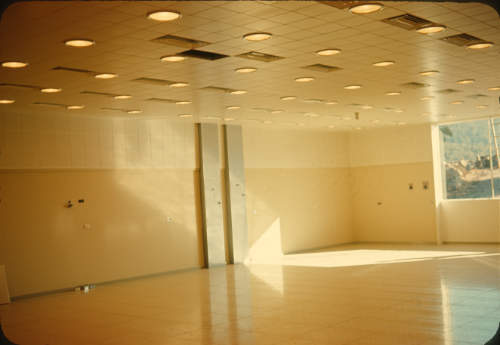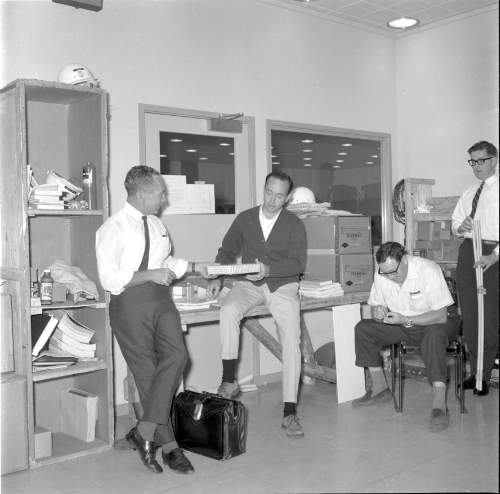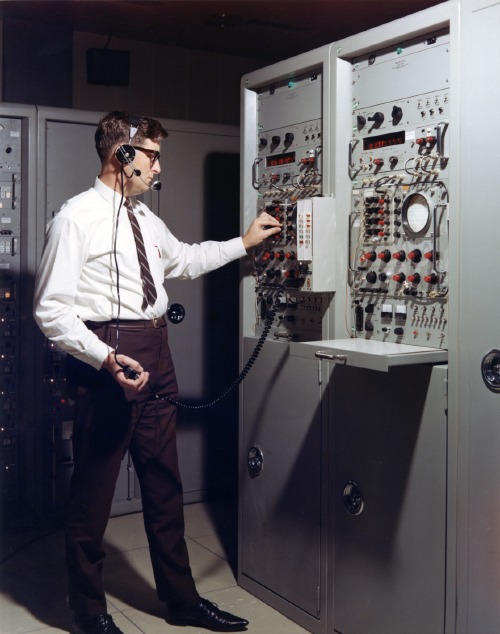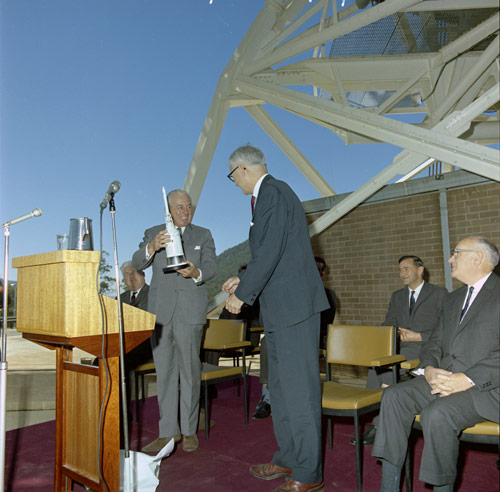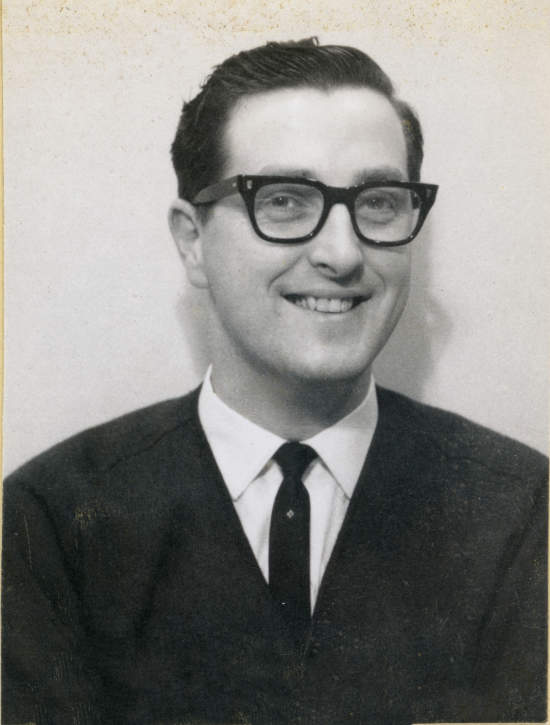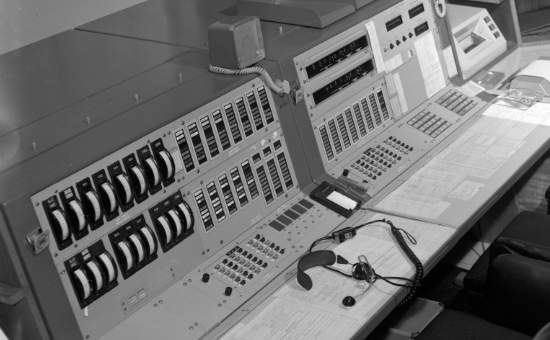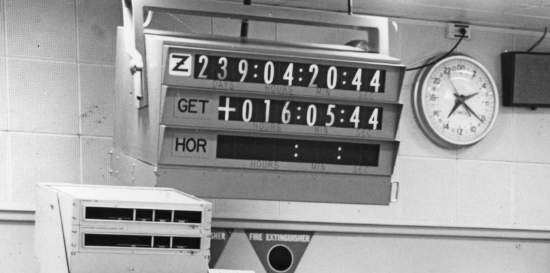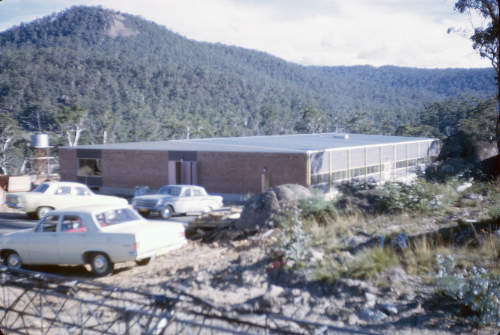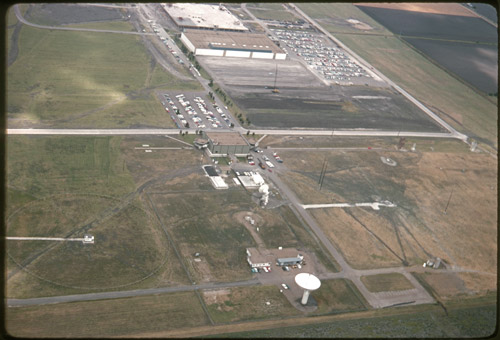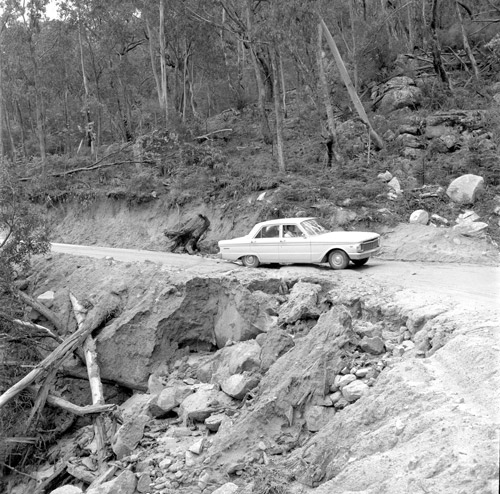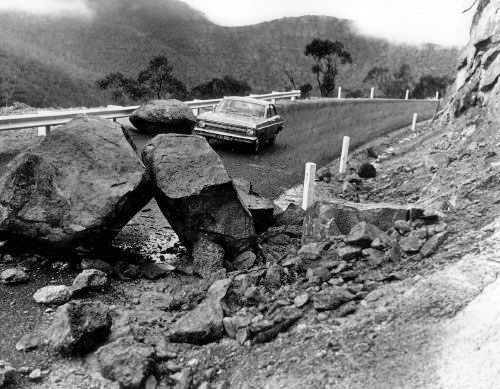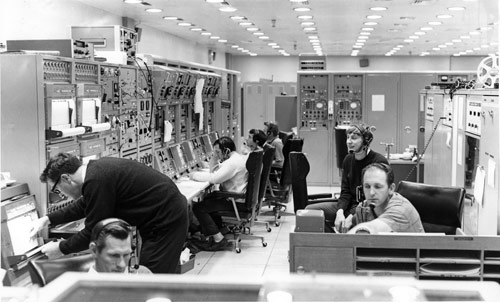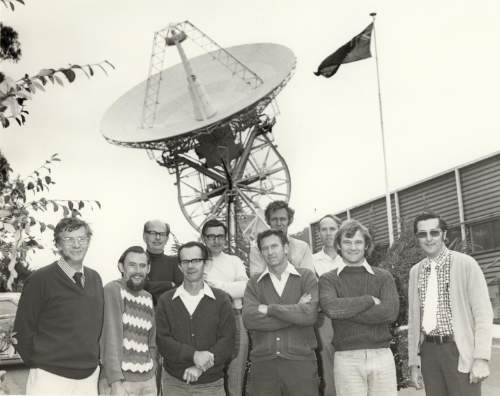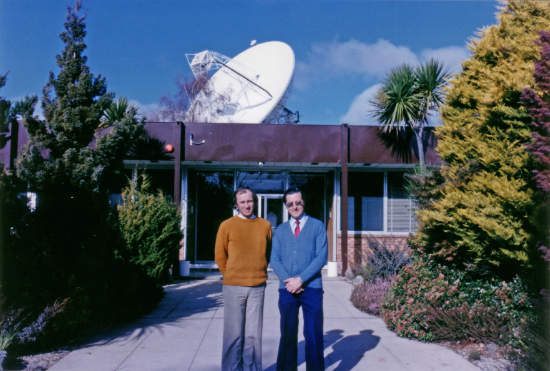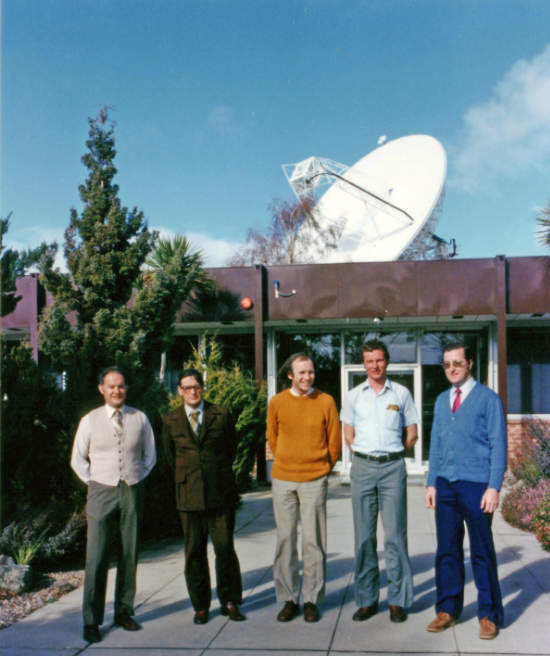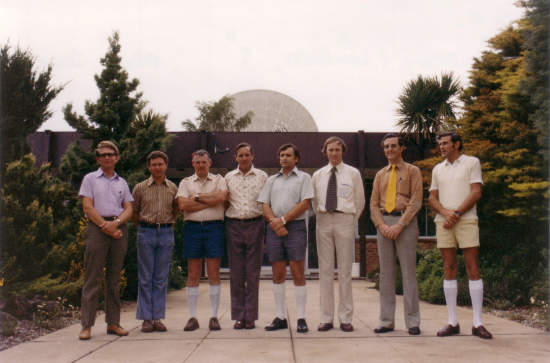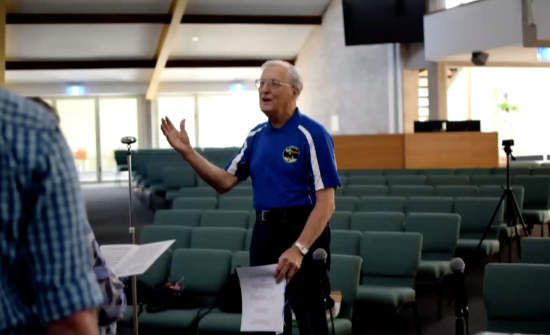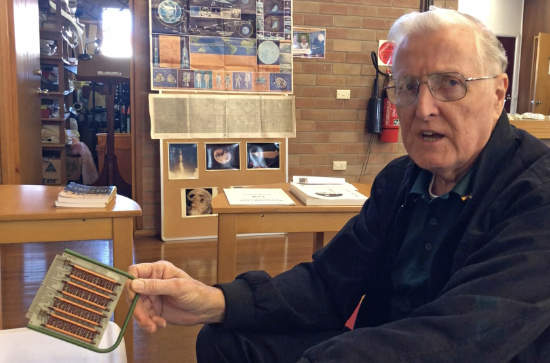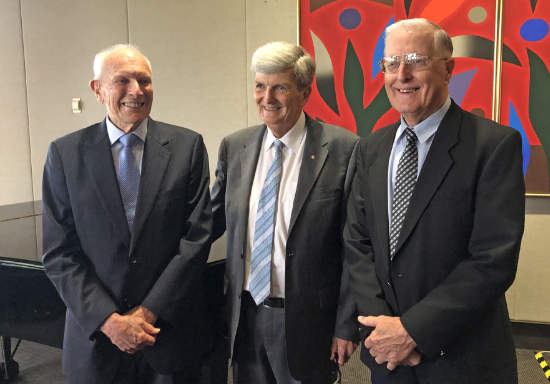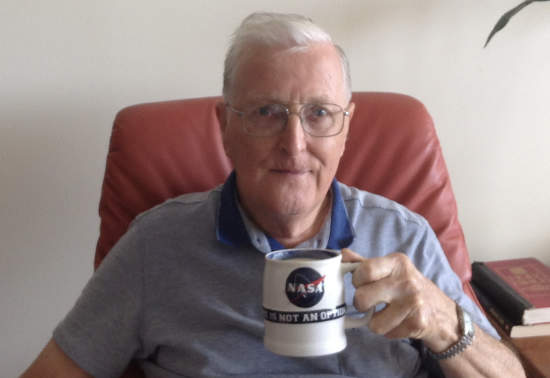Bernard Smith
1939 – 2024
Honeysuckle Creek, Orroral Valley
At Tidbinbilla on 20 July 2019, Bernard Smith points to himself in the post-Apollo-11 Honeysuckle team photo taken 50 years earlier. |
Bernard Lindsay Smith – one of the Honeysuckle originals – was reputedly the only person at Honeysuckle to really understand the Mark 1 Ranging System.
Growing up in Sydney, Bernard was one of the first staff members at Honeysuckle Creek, arriving in April 1966 with an Electrical Engineering degree from UNSW, experience at EMI, and much excitement about what the future might hold.
At this point, the Honeysuckle Operations building was largely completed, but was mostly empty. Construction of the antenna was about to begin.
Inside the empty Honeysuckle Creek Operations Building – SDDS will be installed near the far wall and the Servo console will be positioned near the window looking up to the (not-yet-built) antenna. Transparency C124 from the Tidbinbilla archives. Scan by Colin Mackellar. |
Bernard soon left for training in Unified S-Band Digital Ranging and Timing Equipment at Collins Radio outside Fort Worth, Texas. (Collins was the prime contractor for the Apollo stations.)
Bernard’s Collins Radio certificate at the completion of the course. |
On his return from Texas, Bernard was busy helping install the Ranging System while others worked alongside Collins Radio men to install the other equipment. In this late 1966 photo, Bernard is seen on the right as Collins Radio team leader Ray Cox is presented with a (parting?) gift by Honeysuckle’s Charlie Howe. Honeysuckle’s Bruce Cameron is seated at right. Photo: Hamish Lindsay. 2023 negative scan: Colin Mackellar. |
In the lead up to the official opening of Honeysuckle Creek in March 1967, Hamish Lindsay took a series of photos showcasing the new station. This one, taken on 15th February, shows Bernard at the Mark 1 Ranging System for which he was responsible. Photo HSK - 5/9/7/2 - 20. Scan by Colin Mackellar. |
At the Opening ceremony of Honeysuckle Creek on 17th March 1967, Bernard was responsible for playing the various goodwill messages which had been received. He edited them onto one reel, leaving in some of the Goddard Voice checks for ambience. Listen here. Photo: Prime Minister Harold Holt receives an Apollo model from NASA Deputy Administrator Dr. Robert Seamans. |
Bryan Sullivan preserved this staff ID photo of Bernard taken by Hamish Lindsay in August 1967. (Others here.) |
Honeysuckle’s Deputy Director Mike Dinn recalls that Bernard designed and built the first version of the Honeysuckle Simulation system (later expanded by Neil Sandford for the J Missions).
When Mike requested that meters (sourced from the retiring tracking ship CSQ) be installed on the Honeysuckle Operations Console, Bernard planned and executed the project. This allowed anyone at the Operations Console to monitor key station parameters. Other stations didn’t have this facility.
In this June 1969 photo by Hamish Lindsay of the Operations Console, the vertically-mounted meters from the CSQ tracking ship allow monitoring of key paramaters. Full version on this page. |
In 2020, a C-120 compact cassette tape kept by Hamish Lindsay was digitised by Colin Mackellar. It included audio of Bernard speaking with someone at Goddard Space Flight Center in Greenbelt, Maryland. Asked what it was about, Bernard gave the answer below, and his permission to publish it on the website. It shows the friendly co-operation between the stations and Network headquarters at Goddard – and the inventiveness of Bernard and his colleagues. It would have been recorded around 1972 or 73. Towards the end of the conversation, an RM is mentioned. That’s a Request for Modification, so that changes to equipment were approved and documented. Bernard wrote,
Hear the 9 minute conversation (a 3.5MB mp3 file). Image: Detail from this photo by Hamish Lindsay. |
In December 2022, Bernard told the story of – and sang – a Honeysuckle Christmas Carol written at the end of Apollo 17 in December 1972. He wrote, “The accompaniment is what was used originally and played by my brother.” |
The text below is adapted from the tribute given by Marie Smith at Bernard’s Thanksgiving service at their local church at Stanhope Gardens in western Sydney –
“Bernard Smith was born at the Royal North Shore Hospital in St. Leonard’s Sydney in July 1939 – a few months before the start of World War 2. He had an older brother and sister and a younger brother.They were not well off, but the family of six did have their own modest two bedroom house way out at Pennant Hills. Bernard resided there until he relocated to the A.C.T. for work in 1966.
While he started at the local Primary school, Bernard, was offered a 5th and 6th grade place in the Opportunity Class at Eastwood Primary. This would enable him to enrol at Homebush Boys’ High School – one of only two high schools in Sydney which, at that time, went through to the Leaving Certificate.
Bernard was fascinated by all things electrical; making and fixing things beyond his years, and knew from an early age that he wanted to do Electrical Engineering. That meant he would need to complete the Leaving Certificate to be able to go to University.
His older brother, Robert, was a musical prodigy. Bernard was always in awe of his brother’s musical ability. At age 16, Robert was appointed church organist at Central Baptist Church in Sydney. The family promptly began attending each Sunday. Bernard was 13 at the time. And it was here that Bernard encountered a relationship with Jesus and committed to following him as the Lord of his life.
Bernard matriculated to the University of NSW to study Electrical Engineering, but the family had no means to pay. So Bernard worked full-time whilst attending evening lectures at the University of New South Wales at Kensington from 1957 through to 1965 (9 years part-time). Concurrently, none other than Electric and Music Industries (EMI) at Homebush, started a trainee engineer program. Bernard applied and was employed as a trainee engineer whilst pursuing his degree.
The training program entailed time spent working in each area of the factory production. In this time he learnt many useful lessons. In the paint shop he learnt how to spray paint and this later enabled him to re-spray his FC Holden to look like new. In the metal workshop he was using a milling machine to create spindle slots. It was tedious and repetitive and Bernard did not enjoy being showered with brass cuttings from the guy on the machine behind him. Bernard decided his best approach was to go absolutely flat chat, finish his quota, and get out of there. However by doing this he completely fouled up their bonus system by working at 6 times the bonus speed, which upset the other workers. He was quickly moved off to another area.
Full-time work, part-time study and the daily commute across Sydney can make for a tough slog. But in 1959 the American Evangelist, Billy Graham spent a month running a highly successful series of what were termed ‘crusades’ in Sydney and Melbourne. The Sydney Crusade was a high point in Bernard’s young life. He sang in the massed Choir, trained as a Crusade counsellor, and goodness knows what else. It complemented his regular weekly church involvement singing and teaching Sunday School, oh and driving a bus! It became a fond memory.
He and his first boss developed a great relationship and remained friends for life. His boss moved on from EMI after 5 years and Bernard decided it was time for a different job after completing his degree and graduating in 1965.
At the beginning of April 1966, Bernard started work with STC – Standard Telephones and Cables (Australasia) Pty Ltd – for the Apollo missions at the new Honeysuckle Creek Tracking Station. He considered it an extraordinary experience to be part of these historic space missions.
Honeysuckle Creek Operations Building on 28 April 1966. |
Upon commencement Bernard was sent Texas to Collins Radio for three months training on Digital Ranging and Timing. So in April 1966 Bernard’s first airplane flight was 1st class to the USA.
Hamish Lindsay took this aerial photo of the Collins Radio antenna building and test antennae in June 1966. |
Upon his return to Australia he moved to Canberra to take up his new position. Honeysuckle Creek Tracking Station was up in the hills 40+ kilometres southwest of Canberra.
In the beginning, the daily commute was out through Tharwa and farmland on an unsealed primitive road. It was not unknown for the workers going to and from shift to be confronted with fallen boulders blocking their way, land slides and part of the road missing.
One of the Ford Falcons easing past a washaway on the old track, heading for home after a day’s work. Photo: Hamish Lindsay. Negative scan: Colin Mackellar. |
Another photo of boulders across the road. Photo by Hamish Lindsay, scanned by Mike Dinn. |
Snow chains were required in winter at the bottom of the range before commencing the climb up.
Bernard worked here for the entire Apollo program from start to finish.
At left, Bernard checks the System Monitor chart recorder during one of the Apollo missions (probably Apollo 15 in July/August 1971). Photo: Hamish Lindsay. Scan: Colin Mackellar. |
Bernard thought the most successful mission was Apollo 13, because those astronauts, against all the odds, were got back home alive. It was an amazing feat.
On 13th October 1976, shortly after the Viking 1 unmanned landing on Mars, Hamish Lindsay took this photo of the Honeysuckle Creek Maintenance Team. Bernard is at right. Back Row: Geoff Ruck, Fred Hill, Roy Rae, Neil Sandford. Scan by CM from an 8x10" print preserved by Bernard Smith. |
In 1981, when the signal came out from NASA that they were closing the station at Honeysuckle, Bernard transferred to the Orroral Valley Tracking Station for a time, which was located even further away.
Bernard and a colleague at Orroral Valley, 1981.
Photo via Philip Clark. Image repair: Colin Mackellar.
At Orroral Valley, 1981.
Dick Simons, second from left. Bernard at the right.
Photo via Philip Clark.
At Orroral Valley, 1981.
Ross Murray, Mick Lampart, Roger Lewis, Ernie Cook, Derek Trushell, Geoff Skelton, Bernard Smith, Ian Edgar.
Photo via Philip Clark.
Bernard finally took a redundancy and the family moved back to Sydney, to a new area called Cherrybrook, in time for the start of the 1982 school year. We now had 3 children: Ian starting Year 9, Carolyn starting high school and Janelle in Year 6.
After settling everyone in Sydney, Bernard commenced his third full-time job. It was with the Commonwealth Department of Defence, Royal Australian Navy Trials and Assessing Unit (RANTAU). Part of this position entailed testing and analysing underwater weaponry, such as torpedo firings. He was sometimes required to go to sea for this. At the time our son thought this sounded like such an exciting job: going aboard ships and submarines; doing submarine-to-ship transfers in rolling seas; being lifted off the deck by a harness into a helicopter and so on. Bernard was no adrenaline junky and did not welcome life at sea. Thankfully most of his time at RANTAU was spent on land, in offices at North Sydney and also at their Kingswood facility. He did enjoy this job very much until he retired at 62.
Bernard was exceptionally gifted and he achieved so much both at work and outside of work. He seemed to have the ability of fixing just about anything that needing fixing. During our married life I never once called a tradie to fix or repair anything. He had incredible tenacity to stick with the task until completed, no matter now long it took. He wasn’t going to let anything beat him.
He did all our car maintenance and repairs until cars became computerised and special equipment was required. We always had a block and tackle suspended from our garages to lift engines from vehicles when major work was required. He built so many things.
He was a skilled woodworker. He custom-built our entire kitchen and living room with Tasmanian Oak cupboards, drawers, benches and wall panels at our home in Boundary Road; he built cubby, tree and dolls houses for his kids and grandkids; he even built a complete holiday house for us in Mollymook when we lived in Canberra.
In Pennant Hills we bought a turn-of-the-century heritage house and set about restoring it to its former glory. Bernard stripped back the extensive cedar timberwork which had been painted with white enamel earlier in its life.
Who knew that he could replace the patterned ceiling design after a water leak had damaged the ceiling in the lounge room? This house was on three quarters of an acre with a manicured garden consisting of 80 beautiful heritage roses with exceptional perfume. Although he wasn’t fond of gardening he managed to prune the roses annually without any prior experience. Mowing the manicured lawns and doing edges was a weekly chore which our son helped his dad with every Saturday. There just never seems to be an end to what he could do.
Bernard enjoyed leading hymn-singing for his 80th birthday in 2019. |
Music was his great love, and our home was always filled with music. Bernard taught himself to play the piano in his early teens because his Christian Endeavour group had no accompaniment to sing to. He went on to teach himself to play pipe organs from his twenties onward. He played the pipe organ for fifty years in churches that we attended. He believed that God had given him the talent and therefore he would use it to bring glory to God. He invariably used his organ playing to accompany others, such as choirs and congregations in their worship. He had a fine tenor voice and sang in choirs throughout his life whenever he could.
He fostered a love of music in each of our three children, encouraging them with piano lessons initially, and once they had learned to read music they each chose a portable instrument so that they could be part of bands and orchestras. Ian played trumpet, Carolyn flute and Janelle Clarinet.
They were all in the Western Youth Orchestra during their high school years. Bernard was Orchestra Manager for some of those years. He drove Ian to and from Woden Valley Youth Choir rehearsals every Tuesday evening for 4 years. The girls sang with the Linnet Girls Choir, and again Bernard was involved being the piano accompanist for a number of years.
We don’t know how Bernard ever fitted so much in a day during his working years. Basically, he started early and he finished late. He loved to help people and was generally known as Mr Fix-it.
Our early retirement years allowed us some time to travel and some of that was travelling over much of Australia in our caravan with the company of some other couples. We also enjoyed some overseas travelling.
Family was always top priority. Our three children who, after marrying, blessed us with 8 grandchildren. They all have their own gifts and abilities and have given us both so much joy and proud grandparent moments.
But the real true joy is knowing that all our children and their spouses love Jesus as do most of the grandchildren and Bernard knows that one day we will all be reunited in Heaven. Bernard’s particular role in this cannot be overlooked either. When his brother Robert returned to Australia and was appointed organist/choirmaster at St Thomas’s Anglican, in North Sydney, Bernard dearly wanted to join the choir. Yet he denied himself this opportunity because he also believed that his teenage children needed to belong to a local church where they could receive strong biblical teaching and be a part of a cohort of other young people. He couldn’t accomplish both. So again, he sacrificed his own personal joy and enrichment for the benefit of his family.”
And from Bernard and Marie’s son Ian at the Thanksgiving service –
“If you misunderstood Dad, you might occasionally think him to be a bit of a ‘God-botherer’. If you did understand him, you’d know that Dad believed (like other Christians), that he’s received assurance that he’s in Heaven right now because he gave Jesus total lordship over his life when was here, alive. Given that reality of his, we can see that if he cared about a person at all, he needed to let them know how this could be theirs also if they wanted it. Not to tell them would, to his understanding, be uncaring. And that’s one thing he certainly was not.”
Bernard with a card from Honeysuckle’s Ranging System at an Apollo lunch in Sydney on 21 July 2018. Photo: Colin Mackellar. |
John Crowe (Honeysuckle 1966-67), Andrew Tink and Bernard Smith at the Sydney launch of Andrew’s book “Honeysuckle Creek” at NSW Parliament House in Sydney on 23 November 2018. Photo: Colin Mackellar. |
A favourite photo of Bernard. “Failure is Not an Option.” |
Update:
Bernard’s son Ian has shared these excerpts notes which Bernard wrote some years ago, mainly for his children and grandchildren.
Ian has added the text in square brackets:
“... The first six months at Honeysuckle Creek Tracking Station were spent installing equipment as it arrived. We travelled on a gravel road on the northern or shaded side of the valley. That year we had plenty of snow and rain and the road was extremely muddy. The cars had to be fitted with snow chains in order to get up the hill through the mud. The semi-trailers bringing equipment up the hill had great difficulty, and I remember on one occasion the station 4WD Toyota towing the prime mover and a road works bulldozer pushing the trailer in order to get to the top, a total climb of around 1500 feet or 500 metres.
The official opening of the [tracking] station occurred early in 1967. I had the job of organising and operating the public address system for the occasion. We had previously recorded messages from NASA officials and other important people including the [Vice-] President of the USA, and these were played during the ceremony in such a way that it sounded as if they were coming real time. The Australian Prime Minister, Mr Holt, assumed that the messages had come real time and after the proceedings he asked our communications people to put him through to the Vice-President.
The Apollo program suffered a setback when in January 1967 a fire ...
Apollo 9 followed in March 1969 with the earth orbital first manned flight of the lunar module. In May Apollo 10 took three astronauts to the moon in a trial run for the landing. The spacecraft orbited the moon and the lunar module carrying its two passengers undocked from the command module, fired its descent engine and commenced descent to the lunar surface. The next step was to fire the ascent engine to demonstrate that the lunar module could return to orbit and dock with the command module. Everything took place as planned, so all was ready for Apollo 11 to land on the lunar surface in July. The day before my thirtieth birthday Armstrong and Aldrin set foot on the moon.
Although the initial objectives of Apollo 13 were not achieved, I amongst many others, consider Apollo 13 to be the most successful of the Apollo missions. The spacecraft suffered an explosion ...
... Everyone associated with the Apollo project in Australia and all around the world did their work to their very best in order to get those astronauts back safely. That is what makes it so successful.At Honeysuckle Creek the Computer Engineer had resigned just prior to Apollo 13 and we had a problem with the command computer during the mission. An engineer was flown out from the USA with spare parts to fix the problem. Honeysuckle needed a new Computer Engineer and I was moved to the Computer section to fill this position. I was immediately sent on a ten weeks course to the Goddard Space Flight Centre in Maryland. [1970]. I remained as Computer Engineer for the rest of the Apollo program, and was promoted to Operations Engineer for Skylab [which launched 14 May 1973].
After the ‘Skylab’ project finished in early 1974, Honeysuckle Creek became a Deep Space Station. My job as Operations Engineer for Skylab was finished and, as the Radio Frequency Systems Engineer was leaving, I became the RF Engineer. As the RF Engineer it became my responsibility to go to the deep space station in Johannesburg for the dismantling of the station equipment and the shipment of the equipment to Honeysuckle Creek....
... I became involved in all the Honeysuckle Creek antenna equipment including all the hydraulic systems and the refrigeration for the low noise RF amplifiers. These operated at minus 268.5 degrees Celsius and used liquid helium as the refrigerant. This experience and knowledge became important for my subsequent employment [with the Australian Department of Defence].
During this time the Telemetry and Computer Engineer passed away and I became the engineer responsible for all the station equipment. This responsibility was passed to the engineers at Tidbinbilla Deep Space Communications Complex when I was transferred to the Orroral Valley Tracking Station in December 1979 to replace the Digital Engineer who had just resigned....
... In October 1981 ... a message was received at Honeysuckle Creek from NASA advising that Honeysuckle Creek Tracking Station would be closing in two months. Although I was working at Orroral Valley Station, my contract of employment was for Honeysuckle Creek, so I was eligible for retrenchment. ... We moved to Sydney in January 1982.”
In loving memory of Bernard Smith, and with much thanks to Bernard’s family.

